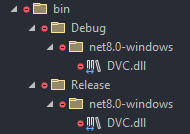DataVista 1.0.3
See the version list below for details.
dotnet add package DataVista --version 1.0.3
NuGet\Install-Package DataVista -Version 1.0.3
<PackageReference Include="DataVista" Version="1.0.3" />
<PackageVersion Include="DataVista" Version="1.0.3" />
<PackageReference Include="DataVista" />
paket add DataVista --version 1.0.3
#r "nuget: DataVista, 1.0.3"
#:package DataVista@1.0.3
#addin nuget:?package=DataVista&version=1.0.3
#tool nuget:?package=DataVista&version=1.0.3
DataVista
DataVista is a .NET library for:
- Database interactions - System.Data.SqlClient (ADO.NET)
- System management utilities - System.Management (WMI)
- WPF
NuGet package
Prerequisites
- .NET 8.0
- System.Data.SqlClient
- System.Management
Quick Start
1. Add the NuGet package to your project
2. Setting up the App.config file (for database interactions)
Add an application configuration file to a C# project
Configure this string for what suits your needs.
<?xml version="1.0" encoding="utf-8" ?>
<configuration>
<configSections>
</configSections>
<connectionStrings>
<add name="MyConnectionString"
connectionString="Data Source=MyServerName;
Initial Catalog=MyDataBaseName;
Integrated Security=True;
Persist Security Info=False;
Pooling=True;
MultipleActiveResultSets=True;
TrustServerCertificate=True"/>
</connectionStrings>
</configuration>
This step is optional because you could always use DataVista.Connection.CreateConnectionString().
Or you could use the SqlConnectionStringBuilder Class.
3. Add the namespace using statement to your .cs file.
Namespace
graph LR;
Core --> ExceptionHandler.cs
Core --> ExtensionMethods.cs
Core --> DVCDLL.cs
DVC.dll --C library--- DVCDLL.cs
Database --> Operation.cs
Database --> DataConverter.cs
Database --> Connection.cs
SQL[(Database)] -.-> Connection.cs
SystemTools --> Framerate.cs
SystemTools --> Hardware.cs
SystemTools --> MemoryUtil.cs
SystemTools --> WinPath.cs
SystemTools --> WinProcess.cs
4. To use methods from DataVista.External, add the DLL file(s) (optional)
Step 1
Go into your solution explorer and select "Show All Files" or open the folder local to your solution.
Step 2
Add the DLL file(s) manually, directly to the /bin/Debug/ and */bin/Release/ folders.

OR
Add the DLL anywhere in the project. Open up the DLL file properties and set the "Copy to Output Directory" property to "Copy always" or "Copy if newer".
Make sure to keep the DLL file(s) up to date.
Docs
Call the appropriate constructor, DataVista.Database.Connection(SqlConnection sqlConnection) will read the connectionString from the App.config file.
| Product | Versions Compatible and additional computed target framework versions. |
|---|---|
| .NET | net8.0-windows7.0 is compatible. net9.0-windows was computed. net10.0-windows was computed. |
-
net8.0-windows7.0
- System.Data.SqlClient (>= 4.8.6)
- System.Management (>= 8.0.0)
NuGet packages
This package is not used by any NuGet packages.
GitHub repositories
This package is not used by any popular GitHub repositories.